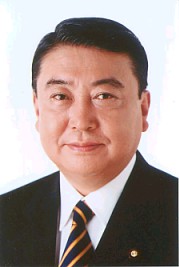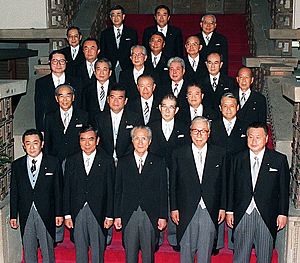Tadamori Ōshima facts for kids
Quick facts for kids
Tadamori Ōshima
|
|
|---|---|
|
大島 理森
|
|

Official portrait, 2002
|
|
| Speaker of the House of Representatives | |
| In office 21 April 2015 – 14 October 2021 |
|
| Monarch | Akihito Naruhito |
| Deputy |
|
| Preceded by | Nobutaka Machimura |
| Succeeded by | Hiroyuki Hosoda |
| Minister of Agriculture, Forestry and Fisheries | |
| In office 30 September 2002 – 1 April 2003 |
|
| Prime Minister | Junichiro Koizumi |
| Preceded by | Tsutomu Takebe |
| Succeeded by | Yoshiyuki Kamei |
| Minister of Education and Director-General of the Science and Technology Agency | |
| In office 4 July 2000 – 5 December 2000 |
|
| Prime Minister | Yoshirō Mori |
| Preceded by | Hirofumi Nakasone |
| Succeeded by | Nobutaka Machimura |
| Director-General of the Environmental Agency | |
| In office 8 August 1995 – 11 January 1996 |
|
| Prime Minister | Tomiichi Murayama |
| Preceded by | Sohei Miyashita |
| Succeeded by | Sukio Iwatare |
| Deputy Chief Cabinet Secretary | |
| In office 2 February 1990 – 5 November 1991 |
|
| Prime Minister | Toshiki Kaifu |
| Preceded by | Takao Fujimoto |
| Succeeded by | Motoji Kondo |
| Member of the House of Representatives | |
| In office 19 December 1983 – 14 October 2021 |
|
| Preceded by | Multi-member district |
| Succeeded by | Junichi Kanda |
| Constituency | Aomori 1st (1983–1996) Aomori 3rd (1996–2017) Aomori 2nd (2017–2021) |
| Member of the Aomori Prefectural Assembly | |
| In office 23 April 1975 – June 1980 |
|
| Constituency | Hachinohe City |
| Personal details | |
| Born | 6 September 1946 Hachinohe, Japan |
| Political party | Liberal Democratic |
| Alma mater | Keio University |
Tadamori Ōshima (Japanese: 大島 理森, Hepburn: Ōshima Tadamori, born September 6, 1946) is a Japanese politician who has now retired. He was a very important leader in Japan's government. From 2015 to 2021, he was the Speaker of the House of Representatives of Japan. This means he was like the main leader of one of Japan's two main law-making groups.
Mr. Ōshima was a member of the Liberal Democratic Party, which is one of the biggest political parties in Japan. Before becoming Speaker, he also held other important jobs. He was the Minister of Agriculture, Forestry and Fisheries, which means he helped manage farming and fishing in Japan. He also served as the Minister of Education, Culture, Sports, Science and Technology, looking after schools, arts, and science.
Contents
Tadamori Ōshima's Early Life and Career
Tadamori Ōshima was born in Hachinohe, Aomori, a city in Japan. He went to Keio University, which is a famous university in Japan. After finishing college, he worked for a national newspaper called Mainichi Shimbun from 1970 to 1974.
In 1975, he started his political career. He was elected to the Aomori Prefectural Assembly. This is like a local government group for the Aomori area. He tried to get elected to the national House of Representatives in 1980 but didn't win that time. However, he tried again in 1983 and was elected for the first time.
After a long career in politics, Mr. Ōshima retired. In January 2023, he was chosen to be a member of the Yokozuna Deliberation Council. This council helps decide who gets the highest rank in sumo wrestling.
Key Roles in Government
Tadamori Ōshima held many important positions in the Japanese government. These roles show how much he helped shape Japan's policies.
Leading the House of Representatives
- Speaker of the House of Representatives (2015–2021): This was his most important role. As Speaker, he was in charge of making sure that meetings in the House of Representatives ran smoothly. He helped guide discussions and votes on new laws.
Cabinet Minister Positions
- Minister of Agriculture, Forestry and Fisheries (2002–2003): In this role, he worked on policies related to farming, forests, and fishing. This is very important for Japan's food supply and natural resources.
- Minister of Education, Culture, Sports, Science and Technology (2000): He was responsible for schools, universities, cultural activities, sports, and scientific research. This role helps shape the future of young people in Japan.
- Director-General of the Environmental Agency (1995–1996): He worked on protecting Japan's environment and dealing with pollution.
Other Important Government Roles
- Deputy Chief Cabinet Secretary (1990–1991): This is a high-level position that helps the Prime Minister manage the government's daily work.
Images for kids
External links
| Political offices | ||
|---|---|---|
| Preceded by Takao Fujimoto |
Deputy Chief Cabinet Secretary 1990–1991 |
Succeeded by Motoji Kondo |
| Preceded by Sohei Miyashita |
Director-General of the Environment Agency 1995–1996 |
Succeeded by Sukio Iwatare |
| Preceded by Hirofumi Nakasone |
Minister of Education 2000 |
Succeeded by Nobutaka Machimura |
| Director-General of the Science and Technology Agency 2000 |
||
| Chair of the Atomic Energy Commission 2000 |
||
| Preceded by Tsutomu Takebe |
Minister of Agriculture, Forestry and Fisheries 2002–2003 |
Succeeded by Yoshiyuki Kamei |
| House of Representatives of Japan | ||
| Preceded by Hidenao Nakagawa |
Chair of the Committee on Rules and Administration 1999–2000 |
Succeeded by Takao Fujii |
| Preceded by Akira Amari |
Chair of the Committee on Budget 2005–2006 2014–2015 |
Succeeded by Kazuyoshi Kaneko |
| Preceded by Toshihiro Nikai |
Succeeded by Takeo Kawamura |
|
| Preceded by Nobutaka Machimura |
Speaker of the House of Representatives of Japan 2015–2021 |
Succeeded by Hiroyuki Hosoda |
| Party political offices | ||
| Preceded by Hiroyuki Hosoda |
Secretary-General of the Liberal Democratic Party 2009–2010 |
Succeeded by Nobuteru Ishihara |
| Vacant
Title last held by
Taku Yamasaki |
Vice President of the Liberal Democratic Party 2010–2012 |
Succeeded by Masahiko Kōmura |
| Preceded by Masahiko Kōmura |
Head of Banchō Seisaku Kenkyūjo 2012–2015 |
Succeeded by Akiko Santo |



